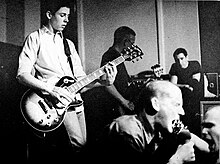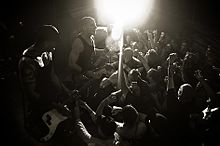I am Straight Edge. Period. For those of you who don’t know what being Straight Edge is, it means that I don’t smoke, drink, or do drugs. I have never done any of these, and I never will. For our generation including all of us here at Skyline, these things consume our culture. One movement, however, can change our generation’s course for the better.
The Straight Edge lifestyle became a subculture here in the United States during the late 70s and into the early 80s. Associated during this time with hardcore punk music were ideals of individualism, doing what you want, and almost hatred of school or work.
The Straight Edge lifestyle became a subculture here in the United States during the late 70s and into the early 80s. Associated during this time with hardcore punk music were ideals of individualism, doing what you want, and almost hatred of school or work.
After this period, the Straight Edge movement underwent a transformation, through the 1980s and 90s, into a subculture with some of the same ideals, but with a new era of influence. The musical element remained, but with the introduction of vegetarianism and veganism, animal rights advocacy, and Straight Edge militant groups.
These two decades defined the controversial aspect of being Straight Edge. In 2000 much of the controversy surrounding the movement disappeared.
For individuals in the movement, or living the lifestyle, the general ideals remain. Smoking, drinking, and drug use is not allowed. For more “hard line” followers, a diet of meat and promiscuous sexual activity is discouraged. Animal rights remain a strong ideal of being Straight Edge.
The most recognizable symbol of the Straight Edge movement is the “X,” either being drawn on the back of hands, on clothing, or in the form of a tattoo. As for how the movement represents themselves, there is some disagreement. For some Straight Edge followers, “playing the part” overshadows the ideals. There is almost a cultural criterion for how someone who is Straight Edge should look or act. There is also emphasis on the music you surround yourself with. However, the term “straight edge” is accepted by most Straight Edge followers, and the general public as somebody who doesn’t like alcohol, smoking, or drugs. This defines the message of Straight Edge.
Unfortunately, my generation fails to hear the message.
According to the Centers for Disease Control, (CDC), their 2010 smoking statistics for young adults ages 18-24 show that 21.4% smoke. Smoking is also known to cause cancer, heart disease, and lung diseases. In the United States, smoking is the leading preventable cause of death, killing one out of five people every year. Worldwide, smokers will die 13-14 years earlier than non-smokers. Excessive alcohol and drug abuse does not fare any better. CDC studies show alcohol abuse can lead to pancreatitis, liver cancer, high blood pressure, and chronic health problems. Drunk driving is one of the leading causes of death among young adults involved in car accidents. It is also shocking to know that most young adults begin drinking under the age of 18, which is definitely illegal. As far as drugs are concerned, a study conducted by University of Cincinnati psychologist Krista Medina in early 2010, showed that the brains of college students are impacted by abuse of prescription drugs and from the chemicals in marijuana. Medina’s research shows that abuse of drugs and alcohol can massively affect the students’ verbal memory and ability to focus, not to mention long-term mental effects. Illegal drug use is one of the largest problems law enforcement agencies face every year. Drug use is present in any area of any city or town.
I believe that our generation has been entirely taken over by a culture where getting drunk, high, or smoking is cool. I don’t understand how getting arrested by the police for being high or getting in a fatal car accident after binge drinking is cool. It’s not and what happens after the fact carries very serious consequences. This is the reality in what we face when making irresponsible decisions. It saddens me to look at those younger than us, especially little children, and realize it won’t be long before they are influenced by a misguided culture. I don’t really know if there is an argument justifying a reason to light up a cigarette and possibly get lung cancer, or doing ecstasy and collapsing from heart failure. I highly doubt it. The financial and emotional toll an addiction leads to is nothing short of a dead end. Whether you watch the news or read about it, addicts who don’t get help meet a terrible fate. This problem affects all of us here at Skyline College. I think if more young people familiarized themselves with the Straight Edge culture, they will find that they will live a much more comfortably healthy and positive lifestyle. The Straight Edge lifestyle protects you from the negative influences of society and commits you to be self-disciplined. This movement can really benefit our generation and turn the tide against so many problems we face.
I know, however, that most of you will continue to smoke, drink, and do drugs after you read this, but just understand the cost. I understand that you can do these things if you want, and you may– I cannot change you. I only hope that you can gain a sense of self-awareness of this never ending problem. I always say that things like alcohol and drugs are the Devil’s gift to man so that he may destroy himself. You, however, always have the choice to either take his offer or refuse it.
Written by: Kiriakos VilchezThursday, September 16, 2010
Originally posted at – http://www.theskylineview.com/opinion/the-straight-edge-lifestyle-1.1601933






